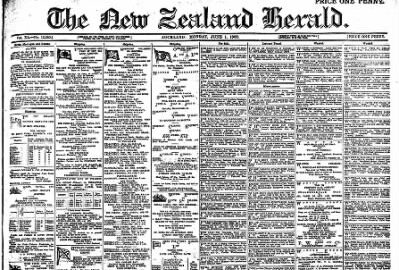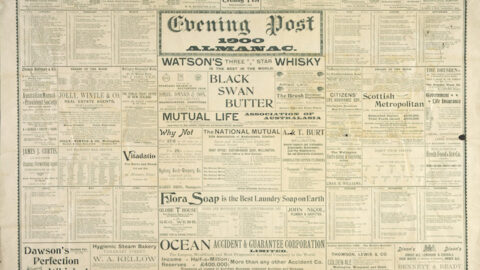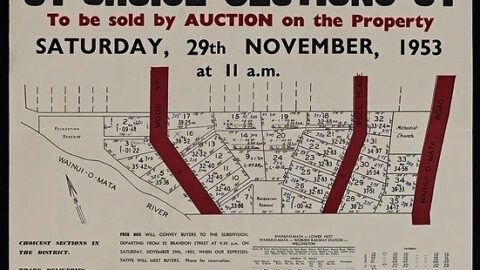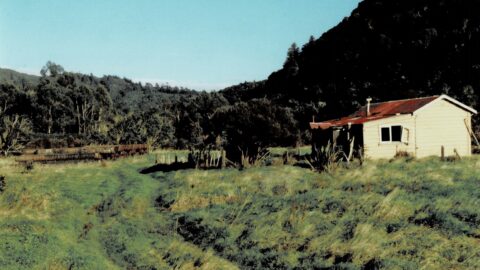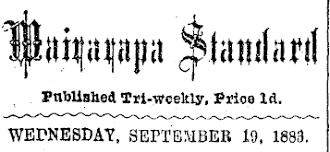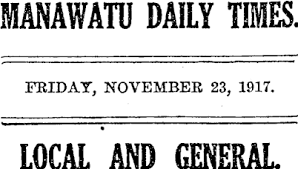WELLINGTON WATER SUPPLY.
The open water-race route is shown in plan and section on four sheets, and also is shown on the general plan of the Wainuiomata District in blue lines with red centres. Starting from the dam at a level of 887 feet above high water mark, it proceeds through a tunnel 3860 chains long into Moore’s Valley; thence up the valley to the entrance of the tunnel into the Swamp, through this tunnel of 9680; thence proceeding up the swamp, winding in and out the various spurs (which, coming from the main range, encloses the valley) on the north-east and north sides of the valley and out into the Hutt Valley by a tunnel 3680 chains in length; the total distance from the dam to Petone being along this route 10 miles 2090 chains.
The alternative water-race route has been laid off with a view of obviating the necessity of bringing pipes to Moore’s Valley, should the pipe route be decided on. It is shown in plan and section (see alternative water-race route), and also is put on the general plan of the Wainuiomata District in black lines with red centres. Its course is identical with that of the open water-race route to the point where the latter crosses Moore’s Valley. It here crosses the valley lower down, and winds along the side of the hills on the north-west side, proceeding down the valley till it joins the pipe route at the entrance to the tunnels into the swamp; the total distance along this route from the dam to Petone being 8 miles 8708 chains.
The pipe route is shown on the accompanying plans in three sheets, in plan and section, and is also plotted on the general plan of the Wainuiomata District in red lines with red centres. Starting from the dam it proceeds through the same tunnel as the open water-race route into Moore’s Valley. Thence down the valley to the entrance of the tunnels into the swamp. At the point where it crosses through the tunnels the main range is split up into two spurs leading from it and forming between them a valley called Sulky Gully. The total length of tunnelling here into the swamp is 6209 chains. Thence crossing over part of the swamp to the road leading to the Hutt Valley, it proceeds along this road to the range of hills abutting on the Hutt Valley, passing through them by a tunnel 25 chains in length. The total distance along this route from the dam to Petone is 7 miles 6550 chains.
The alternative pipe route is shown on the general plan of the Wainuiomata District. By proceeding through the tunnel marked there as “alternative tunnel,” and by laying pipes across the swamp, a saving in distance is effected; the total distance in this case being 7 miles 2969 chains from the dam to Petone; this being the shortest practicable route obtainable.
Auxiliary Supply.—On referring to the general plan of the Wainuiomata District, the course of the River Orongorongo can be seen. It has been examined with the view of its being a possible auxiliary source of.
A meeting of the Waterworks Committee of the City Council was held at four o’clock yesterday afternoon. Present: His Worship the Mayor, and Councillors Hauser, Fisher, Logan, Maginnity, Allen, Moss, Greenfield, and Miller.
Mr. Baird (City Engineer) was present with plans for supplementing the present water supply.
The Mayor asked Mr. Baird to state what information he had to present to the committee on the subject. Mr. Baird said that when Mr. Clark was in Wellington, he went in company with that gentleman to various parts of the country, with a view to ascertaining from whence the present water supply could be supplemented. He had prepared plans in accordance with surveys made and an examination of the localities, and he would now state the result so far as the South Karori Stream was concerned. The intention is to supplement the present supply of water to the town by carrying, by means of a tunnel, the waters of two main branches of the Karori Stream into the present reservoir. The length of the tunnel is about 125 chains, and its line of route is shown on enclosed tracing from the original plan titled “Plan showing line of proposed tunnel joining Karori Creek to present reservoir.” A section along the entire length has been carefully taken, and the levels taken at every chain. See enclosed “section along proposed line of tunnel.” Cross sections have been taken in places along the line of the tunnel, with the view of showing where shafts could be sunk diagonally. See enclosed “cross sections.” A plan of the locality of the proposed dam in the Karori Stream, with cross sections of the bed of the stream, have also been taken, and plans enclosed. The watershed of the Karori Stream above the site of the proposed dam is for the most part timbered and the water good. The volume of the stream has been gauged and found to run 1,300,000 gallons per day.
With regard to the Wainuiomata, he had to report as follows:
The intention is to supply Wellington with water from the Wainuiomata River.
The level of water at the proposed site of the dam across the Wainuiomata River is 377 feet above high water mark.
The route proceeds from Wellington along the railway line at the foot of the main range of hills enclosing Port Nicholson Harbour (see enclosed map of the Wellington Country Districts) on the N.W. to Petone, the commencement of the Hutt Valley, a distance of 6 miles 20 chains; thence across the valley to the foot of the main chain of hills enclosing the harbour on the N.E. (see general plan of Wainuiomata District). Three ranges of hills running in a general parallel direction to the Hutt Valley lie between it and the Wainuiomata River. The land lying between the first and second ranges is of a swampy character, about 300 feet above high water mark, with a very gradual rise towards its head, and about 80 feet below the level of the proposed dam. This valley will be referred to in this report as “the Swamp.” The valley lying between the second and third ranges is called “Moore’s Valley” and contains the Little Wainuiomata Stream; it rises rather rapidly towards its head, but opposite to the proposed dam across the Wainuiomata River is about 50 feet below the level of water there.
In consideration of the above leading features of the country, two main routes have been laid off, viz., an open water race route to the Hutt Valley, and a pipe route. Site of Dam.—An enlarged plan of the Wainuiomata River above and below the proposed site of the dam showing on it in black figures the reduced levels of the stream and of the tongue of land enclosing the area for the waste weir; all of which levels referring to the height above high water mark (see general plan of the Wainuiomata River). A cross section of the dam is also attached.
Supply.
The hills separating it from the Wainuiomata Valley terminate in one low range towards the head of the Orongorongo Stream. A narrow part of this range has been examined, and found to be not more than seven chains through into the Wainuiomata Valley. At this point of the Orongorongo Stream, the volume has been measured and found to be of the capacity of about 3,000,000 gallons per day. Careful barometer observations have been taken in several places along the Orongorongo and Wainui valleys, and the reduced readings (from high water mark) are put on the general plan of Wainuiomata District.
General Conclusions.
—The volume of water flowing daily down the Wainuiomata River, and intercepted by the dam, amounts to 15,000,000 gallons. The watershed is densely timbered, and all the high land belongs to the Crown, which has been applied for by the Corporation. The drainage area cut off by the dam is about 7,000 acres; that of the Orongorongo, above the proposed tunnel into the Wainuiomata, about 2,000 acres.
Tags: Newspaper Pipeline Tunnels Water Race Waterworks
